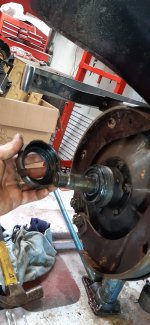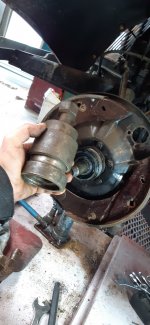Is it as simple as just putting a washer under the nut?
I looked at the parts manual and there was no washer, though I have considered that. I removed the other drum as it was scraping against the driveshaft assembly (so pulling down to deeply into the taper). This one obviously doesn't scrape as it's not torquing down at all (the taper needs to carry the drive forces, not the keyway, otherwise you will strip it all out). I'm pretty sure I'll need to buy a new drum for it
I just like tinkering with the old thing, the tech from this period is fascinating .... though it would be nice to drive the damn thing around for a bit

 .... So we whip the drum off and sure enough, the taper is undersized (its quite clean, so I'm guessing its been turned down in a lathe). So what we are doing here is comparing all the various bits to any spares here ... and are comparing junk to junk. As soon as a known good part is fitted/compared to what we have, its obvious we need to throw away what is there and start again.
.... So we whip the drum off and sure enough, the taper is undersized (its quite clean, so I'm guessing its been turned down in a lathe). So what we are doing here is comparing all the various bits to any spares here ... and are comparing junk to junk. As soon as a known good part is fitted/compared to what we have, its obvious we need to throw away what is there and start again.
 I think I'll try and fabricate some driveshaft tools and do this. I'd prefer to keep the original "taper" type driveshafts in there. As lets be honest, the car is never going to do enough mileage to wear out another set of driveshaft in the next 70years
I think I'll try and fabricate some driveshaft tools and do this. I'd prefer to keep the original "taper" type driveshafts in there. As lets be honest, the car is never going to do enough mileage to wear out another set of driveshaft in the next 70years 
